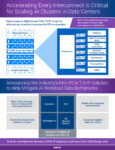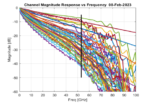As AI and HPC systems scale to thousands of CPUs, GPUs, and accelerators, interconnect performance increasingly determines end-to-end efficiency. Training and inference pipelines rely on low-latency coordination, high-bandwidth memory transfers, and rapid communication across heterogeneous devices. With model sizes… Read More
Tag: pam4
448G: Ready or not, here it comes!
The march toward higher-speed networking continues to be guided by the same core objectives as has always been : increase data rates, lower latency, improve reliability, reduce power consumption, and maintain or extend reach while controlling cost. For the next generation of high-speed interconnects, these requirements … Read More
Samtec Demystifies Signal Integrity for Everyone
As clock speeds go up, voltages go down and data volumes explode the need for fast, reliable and low latency data channels becomes critical in all kinds of applications. Balancing the requirements of low power and high performance requires the mastery of many skills. At the top of many lists is the need for superior signal integrity,… Read More
Empowering AI, Hyperscale and Data Center Connectivity with PAM4 SerDes Technology
The rapid expansion of data-intensive applications, such as artificial intelligence (AI), high-performance computing (HPC), and 5G, necessitates connectivity solutions capable of handling massive amounts of data with high efficiency and reliability. The advent of 224G/112G Serializer/Deserializer (SerDes) technology,… Read More
Synopsys’ Strategic Advancement with PCIe 7.0: Early Access and Complete Solution for AI and Data Center Infrastructure
In the rapidly evolving world of high-performance computing (HPC) and artificial intelligence (AI), technological advancements must keep pace with increasing demands for speed, efficiency, and security. Synopsys recently announced the industry’s first complete PCIe 7.0 IP solution. This groundbreaking initiative addresses… Read More
Synopsys is Paving the Way for Success with 112G SerDes and Beyond
Data communication speeds continue to grow. New encoding schemes, such as PAM-4 are helping achieve faster throughput. Compared to the traditional NRZ scheme, PAM4 can send twice the signal by using four levels vs. the two used in NRZ. The diagram at the top of this post shows the how data density is increased. With progress comes… Read More
Navigating the 1.6Tbps Era: Electro-Optical Interconnects and 224G Links
In the relentless pursuit of ever-increasing data speeds, the 1.6 Terabits per second (Tbps) era looms on the horizon, promising unprecedented levels of connectivity and bandwidth within data centers. As data-intensive applications proliferate and the demand for real-time processing escalates, the need for robust and efficient… Read More
WEBINAR: Why Rigorous Testing is So Important for PCI Express 6.0
In the age of rapid technological innovation, hyperscale datacenters are evolving at a breakneck pace. With the continued advancements in CPUs, GPUs, accelerators, and switches, faster data transfers are now paramount. At the forefront of this advancement is PCI Express (PCIe®), which has become the de-facto standard of interconnect… Read More
Feeding the Growing Hunger for Bandwidth with High-Speed Ethernet
The increasing demands for massive amounts of data are driving high-performance computing (HPC) to advance the pace in the High-speed Ethernet world. This in turn, is increasing the levels of complexity when designing networking SoCs like switches, retimers, and pluggable modules. This growth is accelerating the need for … Read More
JESD204D: Expert insights into what we Expect and how to Prepare for the upcoming Standard
Join our upcoming webinar on JESD204 and get insights into what we predict the upcoming JESD204D standard will contain, based on many years of experience working with JESD204.
Our expert speaker, Piotr Koziuk, has over a decade of experience with JESD204 standards and is a member of the JEDEC Standardization Committee. He will… Read More










